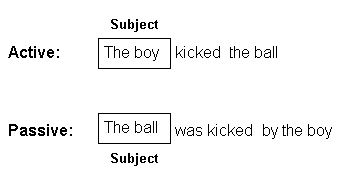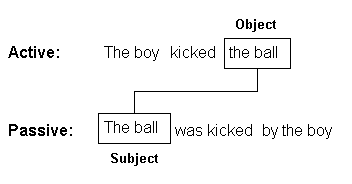| Passive Voice |
Verbs that take a direct object can appear either in the active or passive voice

Compare the above two sentences:
In the active voice, the subject (the boy) of the sentence does the action. In the passive voice, the subject (the ball) receives the action.
Although both voices are grammatically correct, use the active voice in most situations as it is more direct and less wordy.
Appropriate Passive
The passive voice is appropriate ...
- when you want to emphasize the the receiver of the action
The cows were fed with protein supplements made from the internal organs of sheep. - when the doer of the action is unknown
Often, the agent (the doer of the action) is not expressed in a passive sentence. To change the passive voice into the active voice, you must decide on an appropriate subject based on the context.
The farmers fed the cows with protein supplements made from the internal organs of sheep.
Passive Structure
The passive voice is usually formed in the following way:
Noun/Pronoun + "to be" verb + past participle
In the diagram below, you will notice that the object of an active verb corresponds to the subject of a passive verb.

Therefore, the first step to changing a sentence from the active voice to the passive voice is to move the direct object to the subject of the sentence. Next, change the verb form.
Passive Verb Forms
pp = past participle Tense Structure Example simple present am/are/is + pp The roads are swept every morning. present progressive am/are/is being + pp The roads are being swept. simple past was/were + pp The students were punished. past progressive was/were being + pp I was being watched. present perfect have/has been + pp The books have been returned. past perfect had been + pp Jean had been chosen. future perfect will have been + pp The project will have been completed by this weekend. will (future) will be + pp Food and drink will be provided. going to (future) am/are/is going to be + pp A giant pizza is going to be baked.
Main Index | LESOL © Virtual Teacher Aide